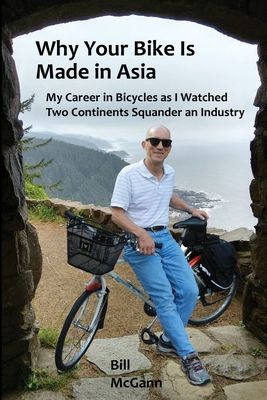At just 144 pages of text, Bill McGann’s new book "Why Your Bike Is Made in Asia: My Career in Bicycles as I watched Two Continents Squander an Industry" is a quick read, but one chock full of industry insight and telling details.
The “Two Continents” part refers to the bicycle and equipment manufacturing capabilities of the legacy brands in the U.S. and Europe.
McGann himself is a long-time member of the U.S. industry. He is a former Category 1 racer, has been a contributor to several cycling magazines and National Public Radio. He is widely acknowledged as an expert on road bikes and cycling history. He is also the former owner of Torelli Imports and Bill’s Bike Shop in Camarillo, California.
"Why Your Bike Is Made in Asia" is a must-have, compulsively readable book for anyone with an interest in the bicycle industry in the U.S. and/or Europe, and/or the rise and subsequent dominance of Asian manufacturing. McGann’s knowledge of events that shaped the bicycle industry on all three continents is nothing short of encyclopedic.
Chapters 1–3 represent a well-researched and thoroughly written history of the bicycle from its earliest days in the 1800s through the Bike Boom of (roughly) 1965–1974, including the rise of the Schwinn, Huffy, Murray, and Ross dynasties in the U.S. and Peugeot and a number of Italian brands in Europe (what I’ve chosen to call the Bike 1.0 era).
For professionals in the bicycle business and anyone with a serious interest in how the industry came to be the way it is today, these three chapters alone are worth the price of the book. They’re full of revealing anecdotes, too.
Among other items of interest, McGann outlines the documented truth about the evergreen Tullio Campagnolo/Croce D’Aune/quick release myth, and shares the priceless tidbit that “into the ‘70s, Peugeot (team) riders were poorly paid and even had to buy their own cycling socks.”
The entire work is full of nuggets like these, but why ruin the fun here? It’s all in the book.
In answer to the question that forms the book’s title, "Why Your Bike Is Made In Asia," McGann provides a clearcut answer early on: “Trek (‘s success with American-made and later Asian-made bikes) showed that the failure of American and European producers to compete with Asian factories was not the fault of location or workforce. As is nearly always true, the suits in the upstairs offices were to blame.” And those suits, McGann, concludes, were responsible for the failure to protect their businesses from the rise of Asian-centric bicycle brands and importers (what I’ve chosen to call the Bike 2.0 era) that continue to dominate the market to this day.
More broadly — and these are my words, not McGann’s — old-school bike brands on both continents were simply too late in recognizing that Asian factories were offering superior products at lower prices, and too complacent to take action about it. They could have maintained their market dominance either by investing in R&D to make better products themselves or incorporating Asian products into their own brands on a timely basis (which some of them ultimately many did, but too little, too late). Over time, this arrogance proved to be their undoing. And, unfortunately for them, the new Bike 2.0 brands labored under no such delusions.
McGann goes on to list the successes of these new brands. Despite a string of frame failures with some of Trek’s early silver-brazed U.S.-made models that caused him to part ways with the company, McGann has nothing but kind words for Trek. “Despite that hiccup,” he writes, “as a result of superb management and a good instinct for what Americans wanted to buy, the company went bravely on without me. Trek went from strength to strength and by the 1990s had far surpassed Schwinn in sales.”
But McGann saves his greatest praise for Specialized and its founder, Mike Sinyard: “He would turn out to be the industry’s most gifted and capable merchant, perhaps the best bicycle businessman of all time.”
One of the highlights is McGann’s analysis of the long decline and eventual fall of the once-dominant Schwinn empire.
The rest of the book details McGann’s insights into the industry’s history of product development, often through the twin lenses of his retail shop and later with his import company, Torelli. The story goes on until health issues forced McGann to sell his retail operation, Bill’s Bike Shop, in 1987, and his Torelli Imports business some 20 years later.
Those already familiar with the definitive Schwinn history, the 1996 "No Hands: The Rise And Fall Of the Schwinn Bicycle Company — An American Institution" may find much of this to be familiar territory. But personally, I think McGann’s telling of the story is more succinct and compelling, if far less detailed. (McGann graciously thanks the No Hands authors, Judith Crown and Glenn Coleman, in his acknowledgements. (For those interested in the longer version, "No Hands" is out of print but still available, albeit rather expensive, through Amazon.)
Another standout section is McGann’s insight into the SRAM story from the company’s early rise with GripShift, to its legal battle with Shimano (which eventually settled out of court; to this day the settlement details are not known), to its rise as a major equipment brand with 2020 sales near the billion-dollar mark and an internally estimated 15% share of the global bicycle component market in 2023.
The book concludes with a summary of the 15 largest worldwide bicycle producers by country. Not surprisingly, China is #1, followed by Taiwan. Italy is #6. France is not listed. The USA is ranked #15.
All in all, "Why Your Bike Is Made in Asia" is a great — and even fun — read, available through McGann Publishing. Print or Kindle versions can also be purchased on Amazon. An audiobook version will be available in mid-October, just as this piece goes to press.




